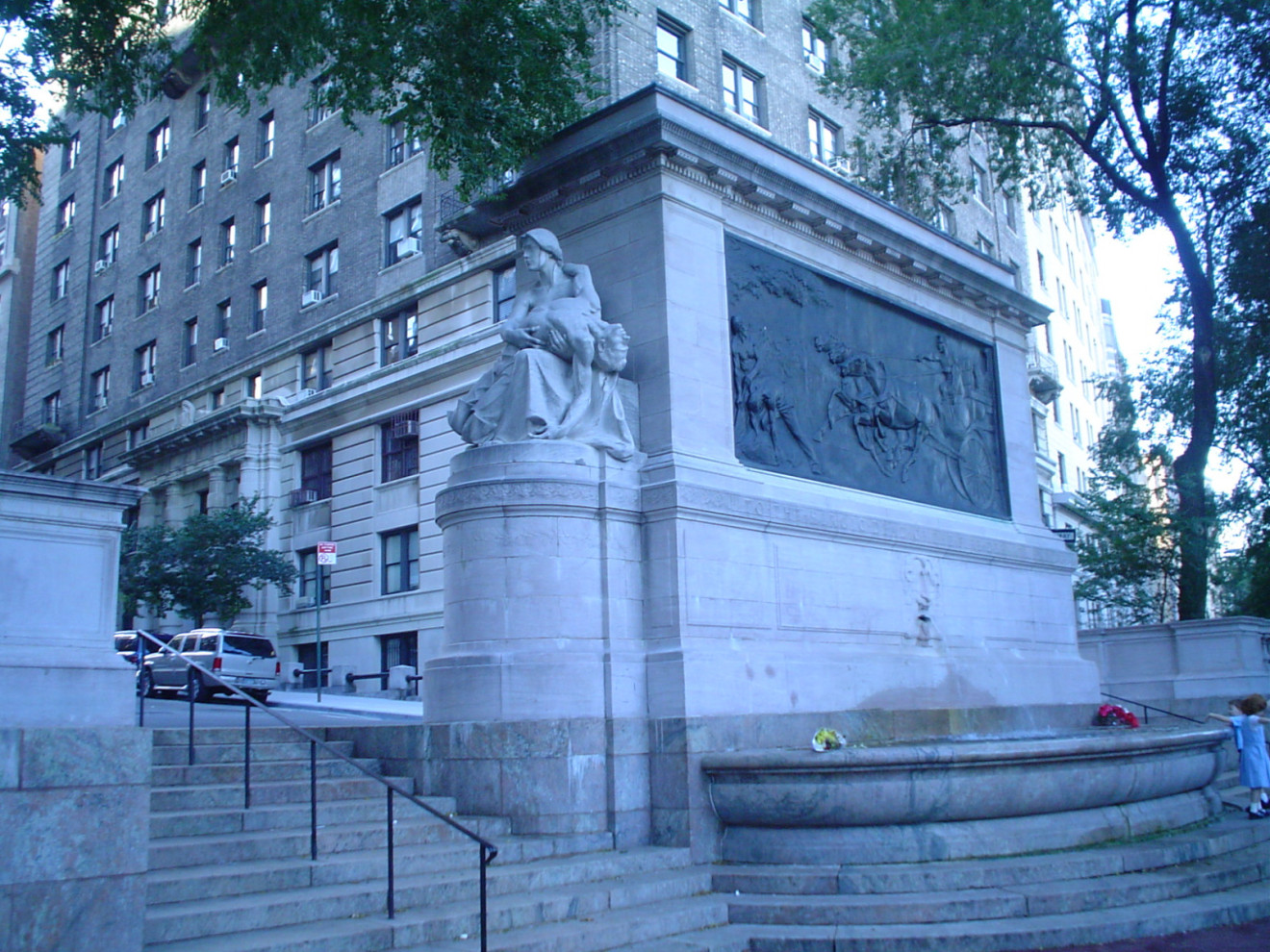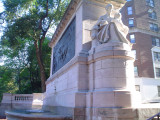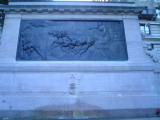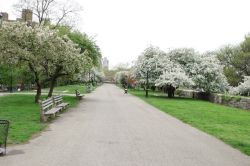Riverside Park
View all monuments in NYC Parks, as well as temporary public art installations on our NYC Public Art Map and Guide.
Firemen's Memorial
| Artist: | Attilio Piccirilli |
| Dedicated: | September, 1913 |
| Location: | Riverside Drive and West 100th Street |
Artwork History
The Firemen’s Memorial (1913) in Riverside Park is one of the most impressive monuments in New York City. The monument was designed by H. Van Buren Magonigle (1867-1935), and its sculptures are attributed to Attilio Piccirilli (1866-1945).
Riverside Drive stretches along Riverside Park and the Hudson River from West 72nd Street to Dyckman Street. When New York started expanding northward, the City acquired land in 1866-67 for a park and scenic drive between the Hudson River Railroad and the rocky bluffs along the river. The original 1875 plan, by Frederick Law Olmsted, the co-designer of Central Park, called for a park with a picturesque drive winding along the natural contours of the land. Twenty-five years later, the result was an English-style rustic park and a formal tree-lined boulevard.
A fashionable address at the turn of the 20th century, Riverside Drive attracted a collection of substantial neoclassical apartment houses and mansions along its eastern side. The Drive’s majestic elevation also made it an impressive location for colossal monuments and institutions, including Grant’s Tomb (1897) and Riverside Church (1930). The Firemen’s Memorial is one of more than a dozen monuments along Riverside Drive, including sculptures of Franz Sigel (1907), Joan of Arc (1915), Samuel Tilden (1926), Lajos Kossuth (1930), and Eleanor Roosevelt (1996).
This monument is said to have had its origins in the remarks of the Right Reverend Henry C. Potter at the funeral of Deputy Fire Chief Charles A. Kruger in 1908. Bishop Potter said that while there were many memorials to public and private citizens there were none “to our brave citizens who have lost or will sacrifice their lives in a war that never ends.” Potter was the first chairman of the memorial committee, succeeded by Isidor Straus (1845-1912), a founder of Macy’s department store, who lived at 105th Street and West End Avenue and died on the R.M.S. Titanic. The committee raised $90,500, of which $50,500 was through popular subscription and $40,000 was in public funds allocated by the Board of Estimate and Apportionment on July 17, 1911.
Though originally intended for the north end of Union Square, the monument was ultimately built on the hillside facing the Hudson River at 100th Street. The memorial comprises a grand staircase (once flanked by ornamental luminaries), a balustraded plaza, a fountain basin, and the central monument. Made of Knoxville marble, the monument is a sarcophagus-like structure with a massive bas-relief of horses drawing an engine to a fire (the original was replaced by a bronze replica in the 1950s); to the south and north are allegorical sculpture groups representing “Duty” and “Sacrifice,” for which the celebrated model Audrey Munson (1891-1996) is said to have posed.
The architect, Magonigle, also designed the memorial to President William McKinley (1843-1901) in Canton, Ohio. Piccirilli, the sculptor, came from a family of master Italian stone carvers who settled in New York City and had a studio in the Bronx. They contributed sculptural and ornamental carving to the Washington Square Arch and the Pulitzer Fountain. Attilio Piccirilli also collaborated with Magonigle on the Maine Monument at Columbus Circle, at the southwest corner of Central Park.
The memorial exemplifies a classical grandeur that characterized several civic monuments built in New York City from the 1890s to World War I, as part of an effort dubbed the City Beautiful Movement, which was meant to improve the standard of urban public design and achieve an uplifting union of art and architecture. This monument has twice undergone extensive restoration, once in the late 1930s, through a W.P.A.-sponsored conservation program, and more recently through a $2 million city-funded capital project completed in 1992.
The monument was dedicated on September 5, 1913, and was formally accepted on behalf of the city by Mayor William Gaynor (1848-1913), who died later that month. Each autumn, the incumbent mayor joins the fire commissioner and thousands of uniformed firefighters at the Firemen’s Memorial to honor the memory of firefighters who have lost their lives in the line of duty. This well-attended ceremony reaffirms the dedication of these public servants, who perform heroic acts on a daily basis.
On September 11, 2001 the Fire Department suffered by far its worst loss in a single day, when 343 firefighters died in response to the terrorist attacks on the World Trade Center’s Twin Towers. Their heroism in the face of death demonstrated extraordinary commitment to the public’s safety, and in the weeks following the tragedy, this monument became a vigil site and shrine for those in mourning.
Artwork Details
| Description: | Monumental sarcophagus-like structure with a bas-relief, groups of figures (over life size) at either end, on terrace with fountain, and balustrades approached by a flight of steps |
| Architect: | Harold Van Buren Magonigle |
| Materials: | Bas-relief--bronze; Other elements--Knoxville marble, Pompton Lakes granite |
| Dimensions: | Monument H: 20'6" W: 37' D: 10'; Terrace W: 66' D: 41' |
| Fabricator: | J. Ward Co. (builder) |
| Donor: | Public Subscription and the City of New York |
| Cast: | 1912 |
Inscription
TO THE MEN OF THE FIRE DEPARTMENT / OF THE CITY OF NEW YORK / WHO DIED AT THE CALL OF DUTY / SOLDIERS IN A WAR THAT NEVER ENDS / THIS MEMORIAL IS DEDICATED / BY THE PEOPLE OF A GRATEFUL CITY / ERECTED MCMXIIPlease note, the NAME field includes a primary designation as well as alternate namingsoften in common or popular usage. The DEDICATED field refers to the most recent dedication, most often, butnot necessarily the original dedication date. If the monument did not have a formal dedication, the yearlisted reflects the date of installation.
For more information, please contact Art & Antiquities at (212) 360-8163.
Check out your park's Vital Signs
Clean & Safe
Green & Resilient
Empowered & Engaged Users
Share your feedback or learn more about how this park is part of a
Vital Park System

Know Before You Go
Related inquiries may be sent to boatbasin@parks.nyc.gov
Related inquiries may be sent to boatbasin@parks.nyc.gov







